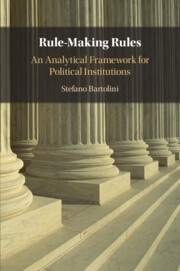Book contents
- Rule-Making Rules
- Rule-Making Rules
- Copyright page
- Dedication
- Epigraph
- Contents
- Figures
- Tables
- Acknowledgements
- Introduction
- Part I On Institutions
- 1 The Origins of Institutions
- 2 Approaches to Institutions
- 3 A Framework for Institutional Analysis and a Typology of Institutions
- Part II On Political Institutions
- References
- Index
1 - The Origins of Institutions
from Part I - On Institutions
Published online by Cambridge University Press: 16 June 2022
- Rule-Making Rules
- Rule-Making Rules
- Copyright page
- Dedication
- Epigraph
- Contents
- Figures
- Tables
- Acknowledgements
- Introduction
- Part I On Institutions
- 1 The Origins of Institutions
- 2 Approaches to Institutions
- 3 A Framework for Institutional Analysis and a Typology of Institutions
- Part II On Political Institutions
- References
- Index
Summary
In Chapter 1 I discuss the available evidence in evolutionary biology, psychology, palaeontology, anthropology and neuroscience on the origins of Homo sapiens’ normative orientations. I review plausible interpretations of the evolutionary emergence of these normative orientations in the histories of humankind and its predecessors. This normative endowment was probably our best-fitting quality, explaining our capacity to emerge as the most effective predator on earth. It is likely that without a long-evolved disposition towards cooperation, humans would never have achieved a stage of civilisation in which it is possible to ask the question ‘how is cooperation possible?’. The chapter also reviews the evidence on whether early political institutions derived from preceding different types of institutions or co-evolved with them.
Keywords
- Type
- Chapter
- Information
- Rule-Making RulesAn Analytical Framework for Political Institutions, pp. 11 - 45Publisher: Cambridge University PressPrint publication year: 2022

